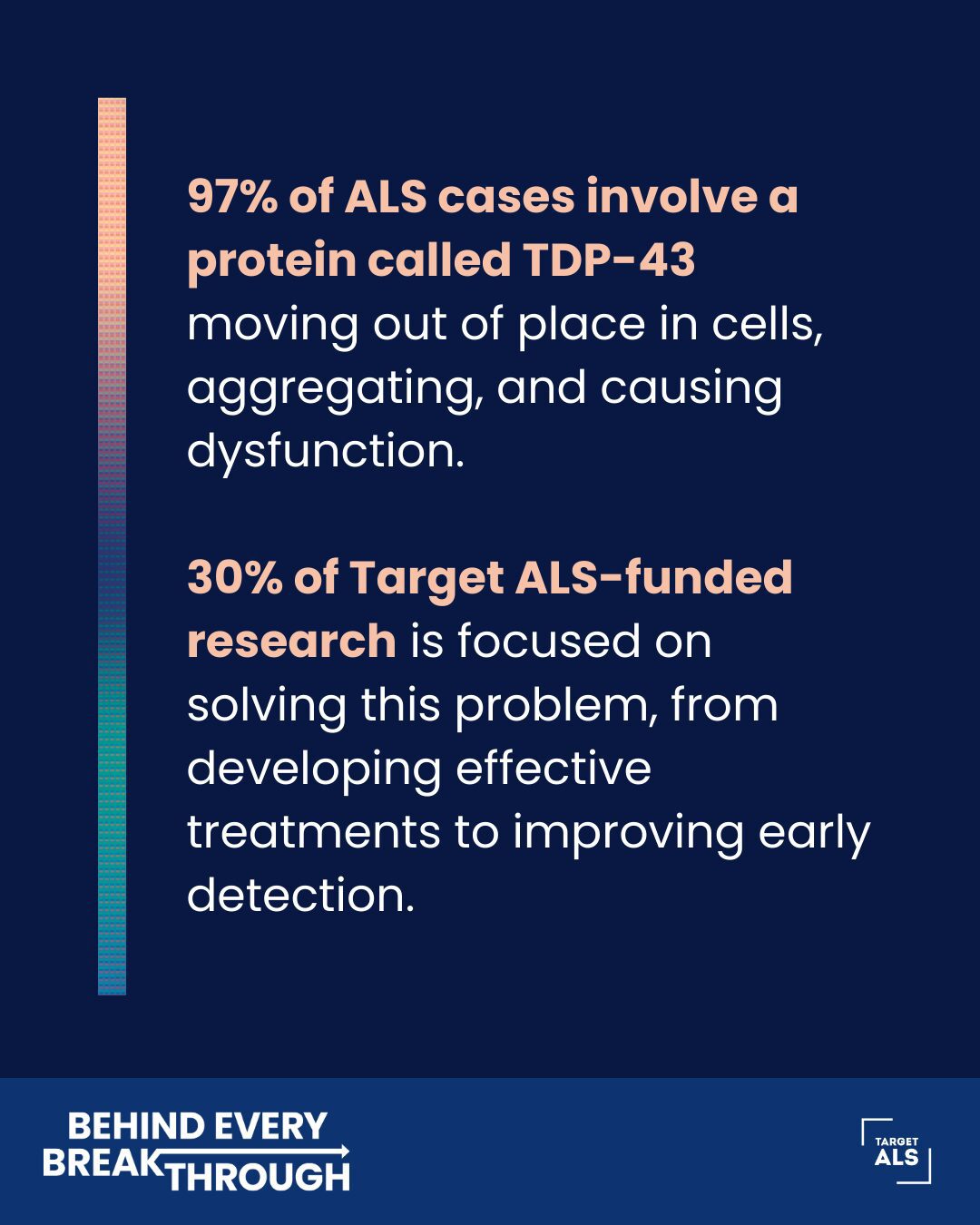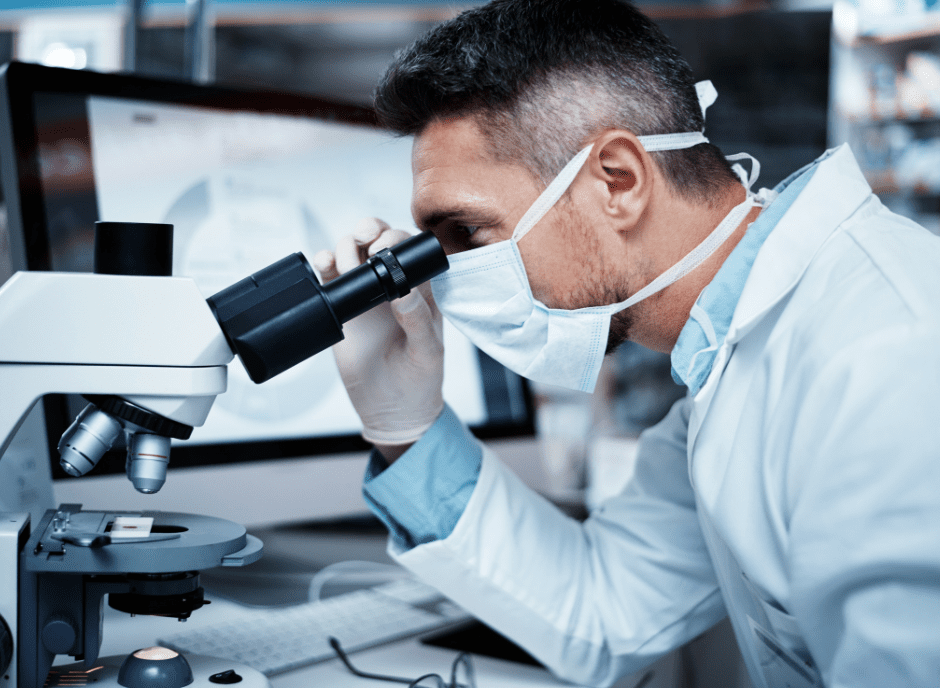
Genomics is a field of biology that focuses on the structure, function, evolution, mapping and editing of genomes—an organism’s complete set of DNA, including all of its genes. As research into ALS continues to advance, genomics is playing an essential role in the discovery of effective therapeutic treatments.
Hemali Phatnani, Ph.D., director of the Center for Genomics of Neurodegenerative Disease (CGND) at the New York Genome Center (NYGC), is on the forefront of those efforts. Her work involves closely examining the mutated genes that contribute to ALS—a particularly challenging aspect of research because of variations involving both the actual genes and outside influences that contribute to mutations.
Despite those complexities, what Phatnani says researchers really need for a breakthrough is more samples, which can only happen with added collaboration. And that’s where Target ALS can help.
In the latest installment of our Under the Microscope series, we spoke with Phatnani about genomics, the importance of insights provided by genomics in ALS research, and how the partnerships facilitated by Target ALS are impacting the industry.
Dive in to ALS Genome Research
Target ALS:
What type of influence does genomics have on ALS and neurodegenerative diseases?
Hemali:
ALS is a very diverse disease that presents differently and progresses with different rates and patterns. What we don’t know is if that variation is completely random or if there are genes that make it more likely for someone to have one kind of presentation or another.
The answer probably lies somewhere in between. Some genes are likely to present themselves in either ALS or frontotemporal dementia (FTD), resulting in cognitive decline. There are others that are almost never associated with cognitive issues. This illustrates the importance that genomics has on neurodegenerative diseases like ALS and dementia, because genomics illuminate these inner workings and gives us precise targets to examine for their role in these diseases.
Target ALS:
What kinds of insights can genomics provide in ALS research?
Hemali:
Mutations to genes like the C9orf72 are highly likely to manifest as ALS and/or FTD, but not every gene is as easy to classify. Mutations in some genes may need to combine with other conditioning factors for ALS to become apparent. Such genetic mutations are more common in the population than those that have a more profound singular effect like the expanded repeat in C9orf72. Understanding the basis of what determines outcomes like these is key to our understanding of how mutations in some genes are associated with ALS.
Target ALS:
What else can you tell us about the genetic architecture involving ALS?
Hemali:
Because ALS can be caused by single-mutated genes like C9orf72, or a combination of genes and outside influences, the genetic architecture of ALS is challenging. In order for us to dig deeper into these traits, we need many different samples to support the research.
Each of us can have multiple different [genetic] mutations, most of which really don’t matter because the majority of us are healthy. While every cell in the body has the same DNA sequence, not every cell looks or performs the same. The difference lies in which genes are expressed [when a cell creates a functional product like a protein] in those cells, and how they are expressed in combination with other genes. For this reason, it’s essential that we examine a wide range of samples to gather and inform data interpretation, identify trends and generate testable hypotheses about the mechanisms that cause disease.
Target ALS:
What more can be done to advance the role of genomics in finding viable treatments for ALS?
Hemali:
The treatment of some diseases can be as easy as finding the mutated gene and targeting it. But in many cases, we just aren’t that lucky. There are ALS trials for genes like the C9orf72, where researchers are trying to correct a particular mutation or the effects of the mutant allele [a gene variant]. But those are the genes that have large effect sizes, and we can point to mutations in that gene as being causative. Unfortunately, that’s not true for all ALS genes or of all the mutations that have been associated with ALS.
If we have clinically well-characterized patients from whom we can get the DNA sequence, and information about how genes are expressed in the tissue of interest, that’s better than just having the DNA alone. We can start to study the relationship between the DNA and how it’s expressed and whether that’s different in each patient.
We’ve been able to stratify [classify] sporadic ALS patients based on their gene expression signatures to generate testable hypotheses because of a certain genetic behavior. With that in place, we can go back to the tissue for testing and to explore if we can generate more evidence for the hypothesis.
With the right samples in place, this could be an extremely powerful resource for our ALS research. But this can only happen if we work together with multiple sites, all of whom are working in concert to bank both samples and data. The more types of data you can study together, the more powerful your approach becomes. So the convergence of biofluid samples collected over the course of disease, post mortem banked tissues, and well characterized patient samples – the clinical data married with the genomic DNA and RNA data – presents a more complete picture.
ALS can affect some regions of the brain more than others. We are investigating what is special about those regions of the brain in order to understand the selective vulnerability of the neurons that break down first with ALS. We also want to understand what makes ALS such an aggressive, fast moving disease.
Target ALS:
What have you and the field identified as trends that help with understanding ALS?
Hemali:
To understand what prompts the effects of those [mutated] genes, we must perform additional testing. Even when we find a gene with the large effect size that we can point a finger to and say, ‘a-ha, that’s the culprit,’ we still must find why there’s a mutation in that gene that makes someone get ALS.
If that mutation is present in all cells of the body, why does it present as ALS and not something else? If we understand how the mutations in that gene are making someone sick, can we learn something about how mutations in other genes are making another person sick? Is there a common thread? Even though we have different genetic causes in different people, do they all converge on the same behaviors at the cellular level that we can target for therapies?
The more types of data that we can bring in and look at together, the better chance we have at learning.
Target ALS:
What about discovering biomarkers for ALS? How is genomics contributing to that?
Hemali:
Most people think of biomarkers only as a way to measure progression of a disease, but they are more important than that. Biomarkers allow researchers to gauge if a drug undergoing testing is working. It’s also a window into a mutated gene’s behavior, so having a good biomarker is crucial.
When you look at diabetes, it’s easy to see why biomarkers matter for all conditions. Glycated hemoglobin from a simple blood test in a clinic can tell us many indicators. It informs us if someone’s diabetes is under control, if there is a predisposition to diabetes and any possible interventions that might help if there is. That’s what we need for ALS, and it can be possible. But we must collect the fluids from which the biomarkers will emerge, in conjunction with analysis of all the other sample types being collected.
Target ALS:
You’re a valued partner of Target ALS and have collaborated with the organization for several years. What unique value do you think Target ALS has brought to the field?
Hemali:
It’s not just the resources. It’s also the way Target ALS builds a community and the collaboration between the science that [the organization] funds, the teams that it puts together and the cores that it builds. It’s a transformative force in ALS.
Because of Target ALS, we don’t have to know someone who has access to tissue. We can go to the website, fill out a form and receive all of the data and tissue that we need. It democratizes ALS research in a way that hasn’t been done before.




